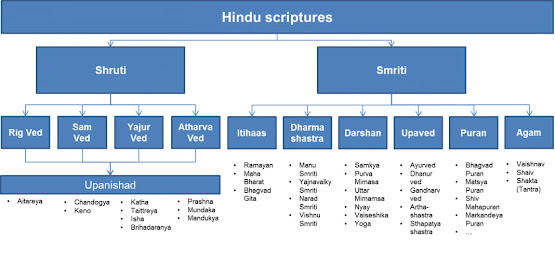Some terms of the Sanatana Dharma Philosophy - Part One
[B] Structure of the Hindu Scriptures:
1. Shruti: Believed to have been heard by the Rishis during their
state of meditation,
directly from the parmeshvara (God), they are called Shrutis (What is heard).
The rishis attained
gnana in the state of samadhi, and hence, it is called shruti.
All the Vedas fall under this category,
so do all the Upnishads.
2. Smruti: Believed to have been created out of human intelligence,
smruti means what is to be
remembered. These texts are written by the
Rishis and are handed down by tradition.
In a way, they are based on the Shruti texts (their interpretation).
They are considered to be less important than the Shrutis.
3. Samhita: Ancient parts of the Vedas, they mean
"to arrange together in a union".
They have sub parts like Mantras, prayers, hyms to the God.
Each Veda is divided into four parts that start
with Samhita and also includes:
- The Brahmanas (ब्राह्मणग्रन्थ) - A guide to rituals, prayers for the priests.
Interpretation and commentaries on
Mantras/Samhitas to
help the priests understand the rituals.
- The Aranyakas आरण्यक - Principles of worship and meditation.
They focus on ritual sacrifice.
They are alone called Karma-Kandas sometimes and
sometimes in conjunction with the
Brahmanas. Some experts opine that Samhitas + Brahmanas = Karma-Kanda
and
Upanishads = jnana-khanda (spirituality-related section).
- The Upanishads - Mystical and Philosophical elements
of the Vedas are described here.
Things like meditation, consciousness,
ontological knowledge (discussion on the existence)
etc. are covered in the Upanishads.
They are not in continuation of the Vedic ritualism.
Vedanta school of the Vedas build heavily on the Upanishads.
Vedanta means the end parts of the Vedas. But many experts believe that
Vedanta should be better translated as the gist of the Vedas.
Practically, each Veda is also referred to as a Samhita. For example:
- Rig-Veda Samhita - The oldest Veda. Praises old Hindu Gods.
Written in a language called Vedic, which got translated into Sanskrit.
The Rig Veda consists of 1028 hymns, organised into
ten books known as maṇḍalas.
The famous Gayatri Mantra is found in this Veda.
- Yajur-Veda Samhita: The Veda containing the rituals of worship.
The priests, performing rituals, have been guided
about the sacrifices to be made during
these holy rituals.
- Sama-Veda Samhita - The chants that are sung
during the sacrifices are mentioned in it.
It is the shortest of the Vedas.
- Atharva-Veda Samhita: A collection spells, prayers and magical charms.
It has spells for healing as well, spells to get rid of demons, spells for love,
- Conclusion: As there are too many texts to introduce (!),
We will discuss about the others later in part two of the article.


